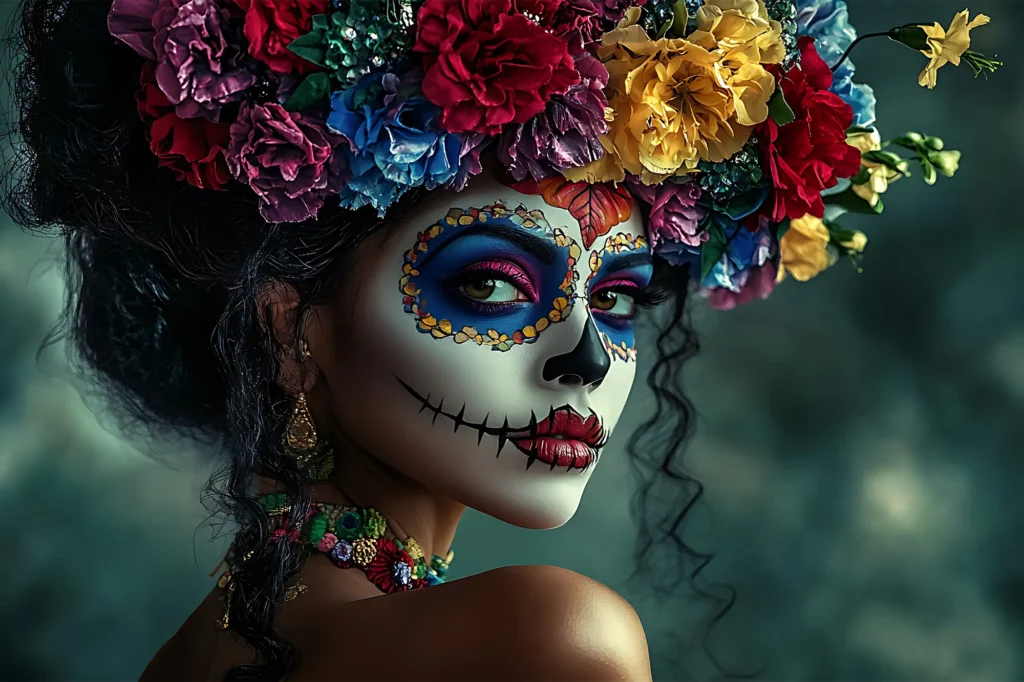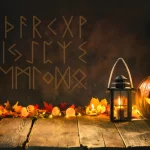Every year, when the Sun enters the magnetic Scorpio, the world shimmers anew. The air feels charged, the veil between realms thins, and something within us stirs. Shadows grow longer, intuition sharpens, and memories hum beneath the surface. This is Día de los Muertos, also known as the Day of the Dead, which happens just after halloween on Novemeber 2nd. It’s a time when love crosses the line between life and death. This festival is colorful, musical, and full of remembrance. It turns mourning into celebration and grief into grace.
In Mexico and Latin America, families prepare for weeks. They clean and decorate graves. They bake pan de muerto and they also create ofrendas, altars with candles, flowers, food, and photos to welcome ancestors home for a night.
Then there’s the calavera makeup: painted skulls full of symbolism. These aren’t just costumes becuase each face becomes a canvas of memory and spirit. It goes deeper than just a halloween outfit. There is so much meaning behind this tradition that needs to be honored and remembered.
The Meaning Behind the Makeup
Calavera makeup is stunning. It features white faces outlined in black and adorned with flowers. But every detail holds intention and history.
The white base symbolizes spirit, the space between life and death. The black lines trace bones, reminding us of our shared structure.
The colors tell their own stories:
Marigold orange is bright. Known as cempasúchil, it’s the “flower of the dead,” guiding spirits home with its light.
Red represents vitality, memory, and love that continues beyond time.
Blue speaks of water and emotion, tears that connect us.
Purple symbolizes mourning and transformation, a sacred hue of change.
Gold and yellow radiate light and guidance, echoing altar candles.
Green embodies renewal, the promise of life returning.
Pink expresses joy and affection, the proof that love never fades.
These colors remind us that life and death are constantly dancing together. Painting the calavera is a connection that turns art into ritual. A type of devotion that connects us to those who have passed. It is an honoring of their life.
The Spirit of La Catrina
Over this season presides La Catrina, the elegant skeleton and face of Día de los Muertos.
Originally created by José Guadalupe Posada in the early 1900s, La Catrina began as social satire on vanity. Over time, she became a symbol of graceful mortality and spiritual equality.
La Catrina reminds us that we all return to the same essence. Under wealth and status, we are united in bone and spirit.
Today, she appears in parades, murals, and altars. People celebrate her for her beauty and wit. She personifies death, but without fear. When people paint their faces like hers, they do so to meet death with dignity and love.
Some designs pay tribute to specific ancestors. For example, there’s a gardener with vines, a musician with notes, and a poet with stars. Others represent entire families or hometown symbols. Each design tells a story, connecting the visible and invisible.
Astrology and the Art of Transformation
Día de los Muertos aligns with Scorpio’s watch, the zodiac sign of death, rebirth, and transformation. The season most fitting to this tradition.
Scorpio, ruled by Pluto and Mars, represents decay and renewal. It shows that nothing really ends; it just evolves. Día de los Muertos mirrors this truth, it’s all about regeneration, not loss.
In astrology, Scorpio rules the eighth house, legacy, and unseen forces that bind us. The ofrenda holds photos and offerings. It shows energy and says, “We remember you, and through memory, you live on.”
The calavera shows Scorpio’s dual nature: beauty and decay. Endings can lead to new beginnings. It also embodies the Death card in tarot, not an omen, but an invitation to transformation.
This season invites reflection. Acknowledge what you’ve lost, what to release, and what can be reborn. Scorpio’s gift is depth, the courage to face darkness and find light. Día de los Muertos is its perfect mirror: a reminder that love can resurrect in mysterious ways.
Faces as Altars
As night falls, the makeup glows in candlelight. Faces shimmer with meaning. Rhinestones gleam like stars. Flowers bloom across cheekbones. For a few luminous hours, the living and the dead move in harmony.
Families often sense their ancestors nearby when they paint. It feels like the act of creation draws them in closer. The brush becomes a bridge to the underworld. The paint becomes prayer and honouring. It is a beautiful way to connect with those who have passed.
As mariachis play and incense rises, the boundary between worlds feels soft. Cemeteries glow with music, laughter, and light. But it is not seen as mourning or grief. It is communion with those that have fallen. And it just shows that love does not vanish instead, it changes form.
The Heart of the Tradition
While Día de los Muertos imagery has spread worldwide, its roots run deep. This is a sacred tradition, a blend of Indigenous belief and Catholic influence. Its purpose is connection. The calavera is not just a decoration because it is a message to the dead: We see you. We honor you. You are still part of us.
For newcomers, intention is key. Learn its meaning. Approach it with respect. Light a candle for someone lost. Write their name. Speak it aloud. Paint your face to honor.
Día de los Muertos, when understood, turns into a universal act of love. It’s a time to think about life’s fragility and how memory keeps us connected.
The Final Reflection
Día de los Muertos is all about transformation. It shows the cycle of endings and new beginnings, loss, and renewal. The makeup fades, candles burn out, and marigolds wilt, but the love they represent endures.
Scorpio shows us that destruction and creation are two sides of the same cycle this season. Every goodbye carries the seed of a new hello. Every death makes room for another kind of life.
So this season, honor that rhythm. Build your altar. Paint your symbols. Light your candles. Call your ancestors home through memory, music, and laughter.
In each marigold petal, each painted face, and every heartbeat under the Scorpio sun, the universe shares its oldest truth: Life is fleeting, but love is infinite.
The post Día de los Muertos: Honoring Ancestors with Symbolic Makeup appeared first on askAstrology.

